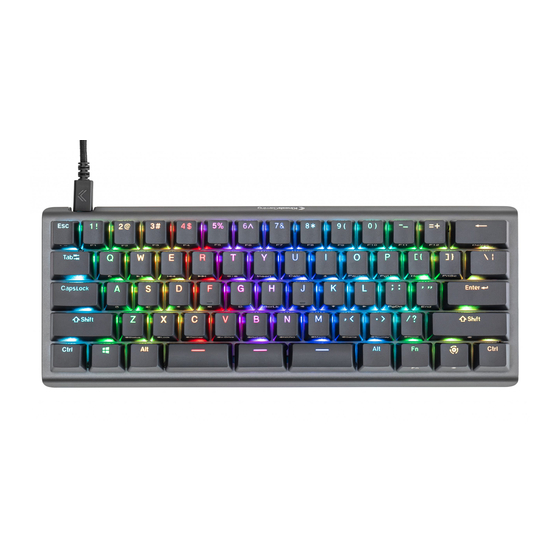
Table of Contents
Advertisement
Quick Links
Advertisement
Table of Contents

Summary of Contents for Kinesis Gaming TKO Tournament Keyboard KBTKO-KBW
- Page 1 KBTKO Direct Programming Guide...
- Page 2 Kinesis Corporation 22030 20th Avenue SE, Suite 102 Keyboard models covered by this manual: Bothell, Washington 98021 USA KBTKO-KBW • KBTKO-KBB www.KinesisGaming.com • KBTKO-KBR • Version 1.0.0 (October 5, 2020) This guide covers features included through firmware version 1.0.0 unless otherwise indicated. To down- load the latest firmware and to access all support resources visit the TKO Support page: www.KinesisGaming.com/tko-support ©...
- Page 3 1.0 Introduction The TKO is a fully-programmable keyboard that does not use any special drivers or software so it can be programmed quickly and easily on all operating systems using the onboard programming shortcuts. Power users have the option to “Direct Program” the keyboard on any operating system (e.g., Windows, Linux, Mac, and Chrome) by editing the simple text (.txt) configuration files stored on the keyboard’s virtual flash drive (the “v-Drive).
-
Page 4: Before You Begin
3.0 Before you Begin 3.1 Power Users ONLY Direct editing requires learning to read and write a custom syntax. The insertion of incorrect characters into any of the configuration files can have unintended consequences and could cause temporary problems with even basic keyboard operation. - Page 5 To successfully re-program the action for a key, each line of code must include a position token and one or more action tokens. The “>“ symbol is used to separate position tokens from actions tokens, and individual tokens are surrounded by brackets. Examples: •...
- Page 6 4.5 Action Token Dictionary Use the “action” tokens below to the right of the “>“ to define the remapped action or the macro contents. HYPH Le Shi Right Shi Le Alt Right Alt Le Windows Right Windows Le Ctrl Right Ctrl &...
-
Page 7: Programming Macros
Programming the Fn Key: The TKO supports two different types of Fn layer access: “Shift” and “Toggle”. The default behavior of the Fn key is “Shift” (i.e., momentary). Note: For proper functionality, it is necessary to assign the desired Fn action token to the position token in both layers, otherwise you’ll get stuck in the Fn layer 4.7 Programming Macros To program a macro, encode the position token(s) corresponding to the desired trigger key(s) and the action... - Page 8 5.0 Direct Programming Lighting Effects The TKO features 9 configurable Profiles, each with its own corresponding series of “lighting configurations” (1-9). Each of the nine lighting configurations are saved as separate .txt files in the “layouts” subfolder on the v-Drive. Each configuration can store up to four effects for that Profile: Deleting a lighting file will permanently delete any custom configurations, but the keyboard will automatically regenerate a the default lighting effect for that Profile the next time the keyboard is replugged.
- Page 9 Examples: 1. Monochrome Solid Green (Top Layer): [mono]>[0][255][0] 2. Monochrome Solid Yellow (Top Layer): [mono]>[255][255][0] Speed: When applicable, the Speed parameter is defined by inputting one a number 1-9 inside the speed token: (spdx) Examples: 1. Reactive Red at Speed 1: [reactive]>[255][0][0][spd1] Direction: When applicable, the Direction parameter is defined by inputting one of the following tokens: [dirup], [dirdown], [dirleft], [dirright]...
-
Page 10: Edge Lighting
With Freestyle mode, there is no effect parameter, simply define the color values for each key. Keys not specified will be unlit. For Breathe, define the Breathe Effect first, specify the Speed parameter, and then define the color values for each key individually or using the Monochrome effect. Example 1: Set WASD keys to static Red, and embedded WASD to static Green [w]>[255][0][0] [a]>[255][0][0]... -
Page 11: Keyboard Settings
5.7 Edge Position Tokens Example 1: Set the left edge to static Blue [L1]>[255][0][0] [L2]>[255][0][0] [L3]>[255][0][0] [L4]>[255][0][0] [L5]>[255][0][0] [L6]>[255][0][0] [L7]>[255][0][0] [L8]>[255][0][0] [L9]>[255][0][0] 6.0 Direct Programming Settings 6.1 Keyboard Settings The current global settings for the keyboard are saved in the “kbd_settings.txt” file in the “settings” sub-folder. Users can update these settings by modifying the fields in this .txt file and then using the Refresh shortcut (SmartSet + Right Shift + B) to implement them. -
Page 12: V-Drive Repair
6.2 SmartSet App Settings In the settings sub-folder you may also notice the “app_settings.txt” file. This file stores your saved preferences for in-App notifications when using the SmartSet App. “On” disables the notification and “Off” enables the notification. 7.0 v-Drive Repair If you disconnect the v-Drive, unplug the keyboard, or use the Refresh onboard shortcut while the PC was actively writing to one of the files (i.e., without ejecting), the next time you open the v-Drive on a Windows computer you may receive a harmless drive error warning.







Need help?
Do you have a question about the TKO Tournament Keyboard KBTKO-KBW and is the answer not in the manual?
Questions and answers